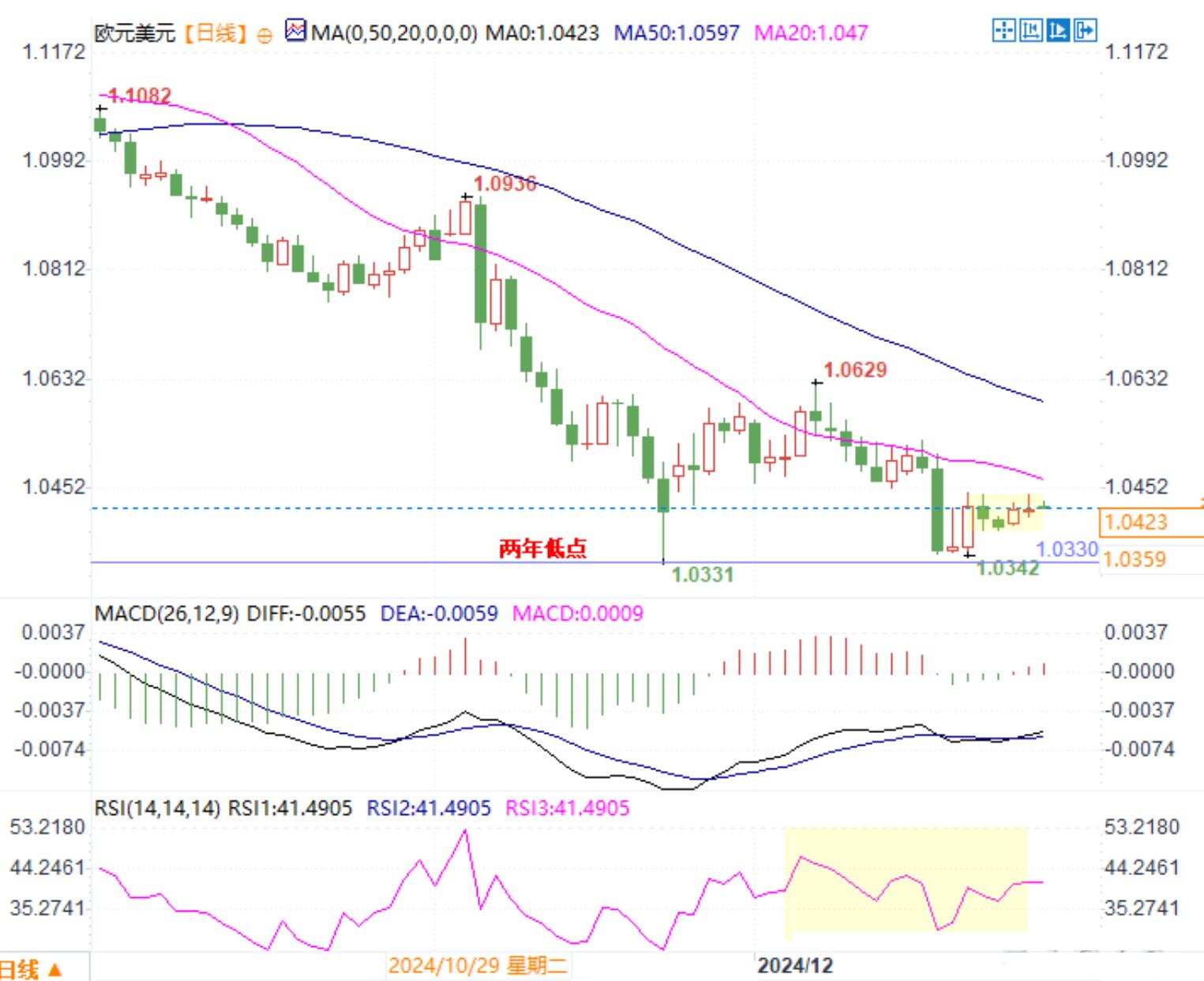Forex trading technical analysis: Euro will have a key breakthrough point!
On Monday (December 30th), as 2024 was coming to an end, the market showed a clear lack of liquidity, and investors left one after another due to the holiday, resulting in low trading volume. In this context, the EUR/USD remains within a small oscillation range above 1.0400. The current market lacks strong directionality, and market participants are mainly concerned about the upcoming release of the US ISM Manufacturing Purchasing Managers' Index (PMI) data and the upcoming year-end holiday.
In the past year, the euro has fallen nearly 5.5% against the US dollar, mainly due to the dovish monetary policy guidance of the European Central Bank (ECB) and the possible impact of US European trade frictions. In this environment, the euro continues to be under pressure, especially in the last few quarters of 2024. Due to market uncertainty, European economic growth prospects, and upcoming tariff issues, investors have a more pessimistic sentiment towards the euro.
Fundamental analysis: dovish guidance from the European Central Bank and trade tensions between the US and Europe
2024 is a challenging year for the euro, especially in terms of the monetary policy stance of the European Central Bank. The ECB lowered the deposit facility rate by 100 basis points to 3% this year and expects to further reduce the rate to 2% by June 2025, highlighting the ECB's concerns about slowing economic growth. The current policy guidance suggests that the ECB may lower its prices by 25 basis points at every meeting in the coming months, further exacerbating market bearish sentiment towards the euro.
Faced with the possibility of tariffs imposed by the United States, the economic growth prospects of the eurozone are even more uncertain. After taking office, US President Trump is expected to exert greater pressure on Europe's export sector, which may lead to a slowdown in economic growth. Especially Trump's remarks about tariffs have further intensified market concerns about the eurozone economy, which has dominated the sustained decline of the euro against the US dollar.
Technical aspect: Vibration consolidation, key support and resistance levels
Technically speaking, the euro against the US dollar is consolidating around a two-year low of 1.0335. Although the current price has slightly rebounded above 1.0400, it still maintains a weak and volatile pattern in the short term. The 20 day and 50 day moving averages (EMAs) of the index are at 1.0464 and 1.0588, respectively, showing a downward trend, indicating that the euro against the US dollar still faces downward pressure. On the 14th, the Relative Strength Index (RSI) remained around 40, indicating that the market is in a weak state. If the RSI remains below 40, it may further increase the downward momentum.
If the price breaks through the two-year low below 1.0330, the euro/dollar may drop to the integer support level around 1.0200. On the contrary, if the price rebounds, the 20 day EMA around 1.0500 will become a key resistance level for upward movement. Considering the insufficient market liquidity, short-term fluctuations may be limited, but if the above technical level is exceeded, market sentiment may quickly change.

US Economic Data and Federal Reserve Policy Outlook
From the perspective of the United States, the strong performance of the US dollar is mainly supported by the rise in US bond yields. The yield of US treasury bond bonds has risen significantly in the past few months. Investors expect that the Trump government will adopt higher tariffs and tax cuts, which will help stimulate US economic growth and inflation. Therefore, the market expects the Federal Reserve to adopt a more hawkish monetary policy. In the recent dot matrix of the Federal Reserve, policy makers generally expect the federal funds rate to remain around 3.9% by the end of 2025, which means that the pace of future interest rate cuts will significantly slow down.
For the upcoming December US ISM Manufacturing PMI data, the market expects the index to slightly decline to 48.3, indicating a slight contraction in US manufacturing activity. This data may have a certain impact on the US dollar, but overall, the US dollar may still maintain a strong pattern.
Future Trends and Prospects
Looking ahead, the short-term trend of the euro against the US dollar may continue to be affected by low liquidity and holiday factors, and overall volatility may be limited. Nevertheless, the dovish policies of the European Central Bank and the trade tensions between the US and Europe remain key factors putting pressure on the euro. If market sentiment continues to be bearish on the euro, the EUR/USD may break through the low of 1.0330 and test the support level of 1.0200.
At the same time, the strong momentum of the US dollar may continue in the coming months, especially with robust US economic data and the possibility of the Federal Reserve maintaining a hawkish stance. Investors will closely monitor the US manufacturing PMI data and other economic indicators to further evaluate the trend of the US dollar.
epilogue
Against the backdrop of low liquidity and cautious market sentiment, the euro against the US dollar maintains a volatile consolidation. Although it may be affected by the year-end holiday in the short term, the euro still faces significant pressure in the medium term, especially under the dual impact of the European Central Bank's dovish policy and the strong performance of the US economy. Investors need to pay attention to the upcoming economic data in order to capture changes in market trends.
Tips:This page came from Internet, which is not standing for FXCUE opinions of this website.
Statement:Contact us if the content violates the law or your rights
